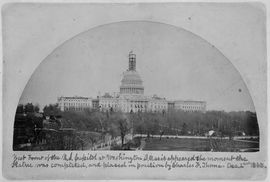
The massive bronze Statue of Freedom has been perched atop the great dome of the United States Capitol since its assembly was completed on December 2, 1863, amidst the pall of civil war. As the crowning feature of the building’s new cast-iron dome, it offered a glimmer of hope that the nation would endure. The continuation of the construction of the dome had served as a symbolic backdrop during the dark war years, but Freedom’s journey to the top of the dome had begun years before.
The Capitol underwent a major transformation during the Civil War. On March 4, 1861, with war looming, President Abraham Lincoln delivered his first inaugural address in the shadow of the half-finished dome. The building was in the midst of a major expansion project that had begun 10 years earlier and included the construction of two large wings and a new, taller dome. At the onset of the war, U.S. Army Corps of Engineers Captain Montgomery C. Meigs, the superintendent of the Capitol extension and dome construction, observed that the government had “no money to spend except in self defense” and issued the order to stop working. Despite this order, the iron foundry hired to construct the dome, Janes, Fowler and Kirtland, continued the project without pay. The foundry worried that the cast iron materials already procured would be damaged or destroyed if installation was delayed.1
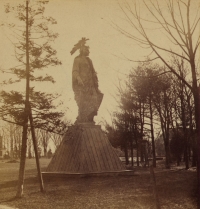
Members of Congress, many of whom shared similar concerns, debated a resolution to restore funding in the spring of 1862. “Every consideration of economy, every consideration of protection to this building, every consideration of expediency requires that it should be completed, and that it should be done now,” Vermont senator Solomon Foot appealed to his fellow senators. “To let these works remain in their present condition is, in my judgment, to say the least of it, the most inexcusable, needless, and extravagant waste and destruction of property,” he argued. “We are strong enough yet, thank God, to put down this rebellion and to put up this our Capitol at the same time.” Congress restored construction funding in April 1862, and the foundry’s dome contract was renewed. Slowly and steadily, the massive dome became a reality during those difficult war years. The vision of this continuing endeavor provided inspiration during this perilous time. “If people see the Capitol going on, it is a sign we intend the Union shall go on,” remarked President Abraham Lincoln. “War or no war, the work goes steadily on,” reported the Chicago Tribune.2
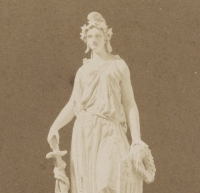
To crown the new dome, Architect of the Capitol Thomas U. Walter, who designed the cast-iron structure, called for a large statue, which he originally conceived as an allegorical figure “holding a liberty cap”—a cloth cap worn by the formerly enslaved in Ancient Greece and Rome that later became a popular symbol of the American and French Revolutions. In 1855 Meigs asked American sculptor Thomas Crawford, who had produced other sculptural pieces for the Capitol project, to create a representation of Liberty for the dome’s statue. Working in his studio in Rome, Crawford instead proposed a figure representing “Freedom triumphant in War and Peace.” His first design, a female holding an olive branch in one hand and a sword in the other, was made before he realized that the sculpture needed more height and a taller pedestal. His second sketch, which Crawford said represented “Armed Liberty,” was a female figure in classical dress wearing a liberty cap adorned with stars and holding a shield and wreath in one hand and a sword in the other.3
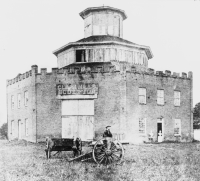
Upon receiving Crawford’s second design, Meigs rightly anticipated that his superior, Secretary of War Jefferson Davis, a Southern enslaver (and future president of the Confederacy) who oversaw the Capitol construction project, would object to the inclusion of the liberty cap. “Mr. Crawford has made a light and beautiful figure of Liberty…. It has upon it the inevitable liberty cap, to which Mr. Davis will, I do not doubt, object,” Meigs recorded in his journal. Indeed, Davis did object. “History renders [the liberty cap] inappropriate to a people who were born free and would not be enslaved,” Davis argued, willfully ignoring the millions of enslaved people who toiled across the nation. “[S]hould not armed Liberty wear a helmet?” Davis offered. Crawford’s third and final design reflected Davis’s suggestion. Freedom was clad with a helmet, "the crest of which is composed of an eagle’s head and a bold arrangement of feathers, suggested by the costume of our Indian tribes," Crawford explained.4
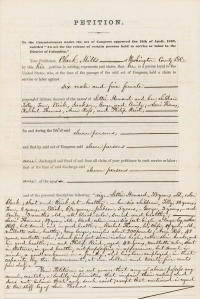
Once the statue design was approved, Crawford prepared a plaster model in his studio, his last work before he fell ill and died in 1857. Divided into five separate pieces, the model was shipped to America. After a long and arduous journey in a ship plagued by leaks, all of the pieces finally arrived in Washington in March 1859. An Italian craftsman working in the Capitol reassembled the model, covering all the seams with fresh plaster, and it was temporarily displayed in the old House Chamber (now known as Statuary Hall). Clark Mills, the owner of a local iron foundry, was hired to cast the statue in bronze in 1860. When the time came to disassemble the plaster model for casting, the Italian craftsman demanded additional pay from Mills, claiming that he alone knew how to separate the model. Mills turned instead to one of his foundry workers, an enslaved African American artisan named Philip Reid, who skillfully devised a method of separating the plaster model so that the individual sections could be cast and the bronze statue assembled. Reid labored seven days a week on Freedom, the only worker in Mills’s foundry paid to attend to the statue on Sundays, according to government records. Reid's rate of pay was $1.25 per day; however, as an enslaved man, he was likely only permitted to keep his Sunday earnings. While Reid was one of many enslaved people who helped to build the Capitol, he is unique in that his name has been documented in official records. “Philip Reid’s story is one of the great ironies in the Capitol’s history,” architectural historian of the Capitol William C. Allen observed, “a workman helping to cast a noble allegorical representation of American freedom when he himself was not free.”5
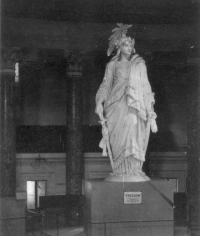
More ironic yet was the fact that when the statue was finally placed atop the dome on December 2, 1863, Reid was a free man, liberated by the District of Columbia Compensated Emancipation Act in 1862 . Reporting from Washington that December day, a correspondent for the New York Tribune recounted Reid’s central role in the creation of Freedom, and reflected, “Was there a prophecy in that moment when the slave became the artist, and with rare poetic justice, reconstructed the beautiful symbol of freedom for America?” The installation of the Statue of Freedom proved to be symbolic, signifying the enduring nation in a time of civil war. A solemn ceremony marked completion of the dome and the placement of Freedom. The “flag of the nation was hoisted to the apex of the dome,” wrote an observer, “a signal that the ‘crowning’ had been successfully completed.” A salute was ordered to commemorate the event, “as an expression…of respect for the material symbol of the principle upon which our government is based.” The 12 forts that guarded the capital city answered with cannon fire when artillery fired a 35-gun-salute—one gun for each state, including those of the Confederacy.6
“Freedom now stands on the Dome of the Capitol of the United States,” wrote the Commissioner of Public Buildings, Benjamin Brown French, in his journal; “May she stand there forever, not only in form, but in spirit.” It was an appropriate finale to a year that began with Abraham Lincoln’s Emancipation Proclamation. “Let us indulge the hope that our posterity to the end of time may look upon it with the same admiration which we do today,” one observer wrote of Freedom that December day, “and an unbroken Union three years since would have viewed this glorious symbol of patriotism and achievement of art.” Indeed, the nation emerged from the Civil War damaged but intact, improved by the permanent emancipation of four million African Americans in December 1865. 7
Notes
3. “Statue of Freedom,” Architect of the Capitol, accessed November 30, 2023, https://www.aoc.gov/explore-capitol-campus/art/statue-freedom; "The Liberty Cap in the Art of the U.S. Capitol," Architect of the Capitol, accessed November 30, 2023, https://www.aoc.gov/explore-capitol-campus/blog/liberty-cap-art-us-capitol; William C. Allen, History of the United States Capitol: A Chronicle of Design, Construction, and Politics (Washington, D.C.: U.S. Government Printing Office, 2001), 246; Allen, Dome, 42.
5. Allen, Dome, 42–43; John Philip Colletta, "Clark Mills and His Enslaved Assistant, Philip Reed: The Collaboration that Culminated in Freedom," Capitol Dome 57, (Spring/Summer 2020): 19; "History of Slave Laborers in the Construction of the United States Capitol," report prepared by William C. Allen, Architectural Historian, Office of the Architect of the Capitol, June 1, 2005, p. 16, included in the subject files of the Senate Historical Office.
6. “The Statue of Freedom,” correspondence of the New York Tribune, reported in the Chicago Tribune, December 14, 1863, 1; "The Statue on the Capitol Dome," National Intelligencer, December 3, 1863, 3; S. D. Wyeth, The Rotunda and Dome of the US. Capitol (Washington, D.C.: Gibson Brothers, 1869), 193.